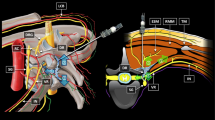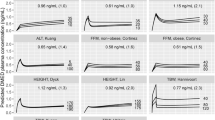Abstract
Objective
To investigate the effects of adding a vasoconstrictor to ropivacaine for epidural anaesthesia.
Patients and methods
This randomised, double-blind study included 44 adults scheduled for urological surgery. Patients received either 20mL ropivacaine 7.5 mg/mL (group R, n = 22) or 20mL ropivacaine 7.5 mg/mL plus epinephrine 5 μg/ mL (group R+E, n = 22) epidurally. Sensory and motor blocks were assessed and the pharmacokinetics of ropivacaine determined. Haemodynamic responses and adverse events were recorded. Patients were followed up for a maximum of 14 days.
Results
The groups were similar with respect to epidural block characteristics. Only one patient in each group experienced inadequate blocks. Median onset of sensory block at surgically relevant dermatomes ranged between 5 and 10 minutes in both groups. No significant difference in onset time was observed between groups. Median duration of sensory block at relevant dermatomes ranged from 3.6 to 5.7h in group R and from 3.3 to 5.9h in group R+E. Haemodynamic changes were moderate and were not considered clinically relevant. The incidence of adverse events was similar between groups. Plasma concentrations of ropivacaine peaked around 30 minutes in both groups; the mean maximum concentration was slightly higher in group R (1.4 mg/L) than in group R+E (1.1 mg/L).
Conclusions
Ropivacaine 7.5 mg/mL with and without epinephrine 5 μg/mL produced equally effective and well tolerated epidural anaesthesia in urological patients. The addition of epinephrine did not offer any pharmacodynamic or pharmacokinetic advantages over ropivacaine alone.





Similar content being viewed by others
Notes
1The use of tradenames is for product identification only and does not imply endorsement.
References
Bromage PR. An evaluation of two new local anesthetics for major conduction blockade. Can Anaesth Soc J 1970; 17: 557–64
Swerdlow M, Jones R. The duration of action of bupivacaine, prilocaine and lignocaine. Br J Anaesth 1970; 42: 335–9
Murphy TM, Mather LE, Stanton-Hicks M, et al. The effects of adding adrenaline to etidocaine and lignocaine in extradural anaesthesia I: block characteristics and cardiovascular effects. Br J Anaesth 1976; 48: 893–8
Buckley FP, Littlewood DG, Covino BG, et al. Effects of adrenaline and the concentration of solution on extradural block with etidocaine. Br J Anaesth 1978; 50: 171–5
Strichartz GR. Neural physiology and local anesthetic action. In: Cousins MJ, Bridenbaugh PO, editors. Neural blockade in clinical anesthesia and management of pain. 3rd ed. New York: JB Lippincott Company, 1997: 35–54
Germishuys PJ. Hyperresponders and adrenaline in local anaesthetic solutions. SADJ 2001; 56: 175–7
Knudsen K, Beckman Suurkula M, Blomberg S, et al. Central nervous and cardiovascular effects of i.V. infusions of ropivacaine, bupivacaine and placebo in volunteers. Br J Anaesth 1997; 78: 507–14
Kopacz DJ, Carpenter RL, Mackey DC. Effect of ropivacaine on cutaneous capillary blood flow in pigs. Anesthesiology 1989; 71: 69–74
Cederholm I, Evers H, Löfström JB. Skin flow after intradermal injection of ropivacaine in various concentrations with and without epinephrine evaluated by laser doppler flowmetry. Reg Anesth 1992; 17: 322–8
Cederholm I, Åkerman B, Evers H. Local analgesic and vascular effects of intradermal ropivacaine and bupivacaine in various concentrations with and without addition of adrenaline in man. Acta Anaesth Scand 1994; 38: 322–7
Nakamura K, Toda H, Kakuyama M, et al. Direct vascular effect of ropivacaine in femoral artery and vein of the dog. Acta Anaesth Scand 1993; 37: 269–73
Gherardini G, Samuelson U, Jernbeck J, et al. Comparison of vascular effects of ropivacaine and lidocaine on isolated rings of human arteries. Acta Anaesth Scand 1995; 39: 765–8
Björk M, Petterson K-J, Österlöf G. Capillary gas Chromatographic method for the simultaneous determination of local anaesthetic in plasma samples. J Chromatogr 1990; 533: 229–34
Mather LE, Tucker GT, Murphy TM, et al. The effects of adding adrenaline to etidocaine and lignocaine in extradural anaesthesia II. Pharmacokinetics. Br J Anaesth 1976; 48: 989–94
Burm AGL, van Kleef JW, Gladines MPRR, et al. Epidural anesthesia with lidocaine and bupivacaine: effects of epinephrine on the plasma concentration profiles. Anesth Analg 1986; 65: 1281–4
Ohno H, Watanabe M, Saitoh J, et al. Effect of epinephrine concentration on lidocaine disposition during epidural anesthesia. Anesthesiology 1988; 68: 625–8
Scott B. Adrenaline in local anesthetic solutions. Acta Anaesth Belg 1988; 39: 159–61
Tucker GT, Mather LE. Pharmacokinetics of local anaesthetic agents. Br J Anaesth 1975; 47: 213–24
Tucker GT, Mather LE. Clinical pharmacokinetics of local anaesthetics. Clin Pharmacokinet 1979; 4: 241–78
Burm AGL, Vermeulen NPE, van Kleef JW, et al. Pharmacokinetics of lignocaine and bupivacaine in surgical patients following epidural administration: simultaneous investigation of absorption and disposition kinetics using stable isotopes. Clin Pharmacokinet 1987; 13: 191–203
Emanuelsson BMK, Persson J, Alm C, et al. Systemic absorption and block after epidural injection of ropivacaine in healthy volunteers. Anesthesiology 1997; 87: 1309–17
Forsberg T, Westman I, Åkerman B. Difference in vasoactivity between ropivacaine and bupivacaine. Anaesthetist 1988; 37( Suppl. 4): 121
Kristensen JD, Karlsten R, Gordh T. Spinal cord blood flow after intrathecal injection of ropivacaine: a screening for neurotoxic effects. Anesth Analg 1996; 82: 636–40
Iida H, Watanabe Y, Dohi S, et al. Direct effects of ropivacaine and bupivacaine on spinal pial vessels in canine. Anesthesiology 1997; 87: 75–81
Nolte H, Fruehstorfer H, Edström H. Local anaesthetic efficacy of ropivacaine. Reg Anesth 1990; 15: 118–24
Hickey R, Candido KD, Ramamurthy S, et al. Brachial plexus block with a new local anaesthetic. 0.5 per cent ropivacaine Can J Anaesth 1990; 37: 732–8
Cederholm I, Anskär S, Bengtsson M. Sensory, motor, and sympathetic block during epidural analgesia with 0.5% and 7.5% ropivacaine with and without epinephrine. Reg Anesth 1994; 19: 18–33
Acknowledgements
The study was performed at St Thomas’ Hospital. This work was sponsored by a research grant from Astra Pain Control AB, Södertälje, Sweden.
We acknowledge the contribution of Dr Torbjörn Arvidsson, Department of Bioanalytical Chemistry, AstraZeneca R&D Södertälje, Sweden.
Author information
Authors and Affiliations
Corresponding author
Rights and permissions
About this article
Cite this article
Pither, C.E., Emanuelsson, BM., Reventlid, H. et al. A Comparison of the Dynamics and Pharmacokinetics of Ropivacaine 7.5 mg/mL with and without Epinephrine Used for Epidural Anaesthesia in Urological Surgery. Clin. Drug Invest. 23, 245–253 (2003). https://doi.org/10.2165/00044011-200323040-00004
Published:
Issue Date:
DOI: https://doi.org/10.2165/00044011-200323040-00004




